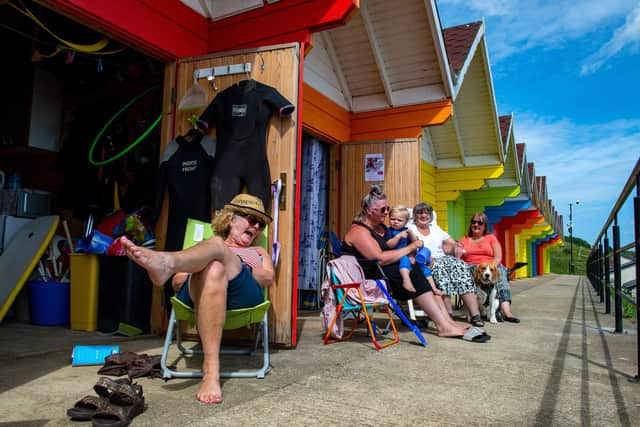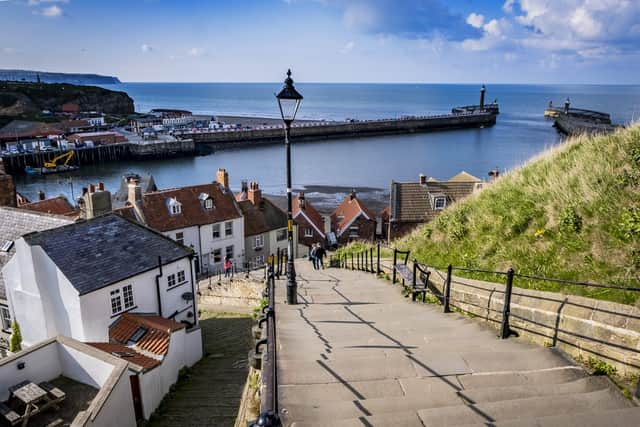Wish you were here... Reviving the great British seaside postcard
“Wish you were here,” they scribbled fondly from the promenade, to their loved ones back home. Sometimes they added a question mark for a flourish of one-upmanship.
The cult of postcards has given way to more instant forms of communication – so much so that their 150th anniversary this month had threatened to pass unnoticed. But The Yorkshire Post, in a small revival of the tradition, has produced six of its own which celebrate not only the holiday jewels of the east coast but also the art of the bon mot, as expressed in a few lines on the back of a picture of the seaside idyll their writers are enjoying.
Advertisement
Hide AdAdvertisement
Hide AdIt was in 1870 that the first postcards appeared in Britain. They were produced by or under restrictive licence from the Post Office, and the stamp formed part of the design. But at just a ha’penny, they were half the price of a regular letter, and their success was immediate.


In an age when letter writing was an obsession, neither the brevity of the new format nor the absence of privacy were an impediment, and in the first year, some 75 million were said to have been sent.
Within a few years, the rules were relaxed further to allow the photographic postcards with which seaside resorts in particular would be forever associated.
“Photography itself was a novelty then, and the cameramen of the day would roam the streets taking one-off pictures which are highly valued by collectors to this day,” said Steve Kentfield, secretary of the Postcard Traders’ Association.
Advertisement
Hide AdAdvertisement
Hide Ad“Then there were the seafront photographers who took pictures and turned them into postcards which they made available later the same day.


“People didn’t have their own cameras, so buying a souvenir postcard was what people did, and their family and friends back home would often save them.”
Nowhere was the seaside postcard more at home than Scarborough, where one of the biggest printing houses was based. Edward Dennis founded his company there just weeks after picture cards became permissible, and consequently the North Bay was one of the first – if not the first – seaside destinations to be seen by friends back home.
The local landmarks captured for posterity include some lost even to present-day memory.
Advertisement
Hide AdAdvertisement
Hide Ad“The oldest cards tell a hidden history of Scarborough,” said historian Mike Hitches, whose books include timelines of the town and the nearby resorts of Filey and Bridlington.
“I’ve seen postcards which show the Victorian pier on the North Bay, which blew down in 1905. And there are pictures of Victorian bathing machines on the beach, which were pioneered in Scarborough and which allowed female bathers to preserve their modesty before entering the water.”
Postcards of such contraptions – actually horse drawn wooden sheds on wheels – are highly prized today, said Mr Kentfield, whose society organises regular trading events in York, Leeds and around the country.
“Apart from one-off postcards such as those sent from the Titanic, the ones that fetch the most money are street scenes. Individual cards have been known to go for £1,500.
Advertisement
Hide AdAdvertisement
Hide Ad“People find it hard to believe, but these cards represent a golden age, and their revival today is fuelled by nostalgia for that time.”
In the post-war years, one Yorkshire name was synonymous with the cheeky cartoon postcards that were a staple of the great British seaside holiday.
The 50,000 variations turned out over the decades by the Bamforth company, based in Holmfirth and then Leeds, reflected the changing times as they became steadily more saucy. The firm was eventually bought by the Dennis company in Scarborough.
The graphic artist Donald McGill was the pioneer of seaside postcards which relied on sex, rather than scenery, and the familiar cast of buxom young women, fat old ladies and drunken men were his creation.
Support The Yorkshire Post and become a subscriber today.
Advertisement
Hide AdAdvertisement
Hide AdYour subscription will help us to continue to bring quality news to the people of Yorkshire. In return, you’ll see fewer ads on site, get free access to our app and receive exclusive members-only offers.
So, please – if you can – pay for our work. Just £5 per month is the starting point. If you think that which we are trying to achieve is worth more, you can pay us what you think we are worth. By doing so, you will be investing in something that is becoming increasingly rare. Independent journalism that cares less about right and left and more about right and wrong. Journalism you can trust.
Thank you
James Mitchinson
Comment Guidelines
National World encourages reader discussion on our stories. User feedback, insights and back-and-forth exchanges add a rich layer of context to reporting. Please review our Community Guidelines before commenting.